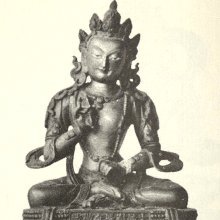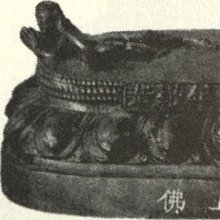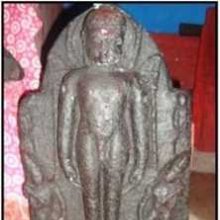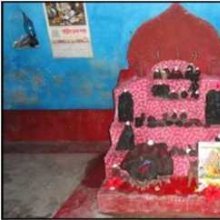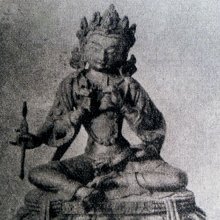Shakra, Śakra, Sakra, Śākra: 35 definitions
Introduction:
Shakra means something in Buddhism, Pali, Hinduism, Sanskrit, Jainism, Prakrit, the history of ancient India, Marathi, Hindi. If you want to know the exact meaning, history, etymology or English translation of this term then check out the descriptions on this page. Add your comment or reference to a book if you want to contribute to this summary article.
The Sanskrit terms Śakra and Śākra can be transliterated into English as Sakra or Shakra, using the IAST transliteration scheme (?).
Images (photo gallery)
In Hinduism
Ayurveda (science of life)
Source: Wisdom Library: Āyurveda and botanyŚakra (शक्र) is a synonym for Kuṭaja (Wrightia antidysenterica, “Kurchi fruit”), from the Apocynaceae family. The term is used throughout Ayurvedic literature such as the Carakasaṃhitā. This synonym was identified by Amarasiṃha in his Amarakośa (a Sanskrit botanical thesaurus from the 4th century). Śakra literally translates to “powerful one” and is an epithet for Indra (king of the devas in Vedic Hinduism).

Āyurveda (आयुर्वेद, ayurveda) is a branch of Indian science dealing with medicine, herbalism, taxology, anatomy, surgery, alchemy and related topics. Traditional practice of Āyurveda in ancient India dates back to at least the first millenium BC. Literature is commonly written in Sanskrit using various poetic metres.
Purana and Itihasa (epic history)
Source: archive.org: Puranic EncyclopediaŚakra (शक्र).—A synonym of Indra. (See under Indra)
Source: archive.org: Nilamata Purana: a cultural and literary studyŚakra (शक्र) is the name of a Nakṣatra mentioned in the Nīlamatapurāṇa verse 784. As regards the heavenly bodies, the Nīlamata refers to the sun, the moon, the planets and the stars. The divisions of the time are also mentioned as objects of worship.
Source: Cologne Digital Sanskrit Dictionaries: The Purana Index1a) Śakra (शक्र).—(Śatakratu) a son of Aditi, and surname of Indra (s.v.); his brother Upendra;1 deceived Rāji accepting him to be his son in the first instance and finally contrived to oust him from Indrahood.2
- 1) Bhāgavata-purāṇa VI. 6. 39; 10. 18; Brahmāṇḍa-purāṇa II. 6. 11; Vāyu-purāṇa 30. 95, 109; 61. 30; 96. 196; 97. 23.
- 2) Vāyu-purāṇa 92. 88.
1b) A son of Śoṇāśva.*
- * Matsya-purāṇa 44. 79.
1c) A son of Śūra.*
- * Vāyu-purāṇa 96. 137.
1d) An Āditya.*
- * Viṣṇu-purāṇa I. 15. 130.
1e) Indra;1 attended on Diti and cut the embryo in seven parts and later into forty-nine pieces; these are the Maruts;2 city of Vaśankasāra;3 joined Bṛhaspati in the Tārakāmaya;4 father of Arjuna.5
- 1) Viṣṇu-purāṇa V. 11. 1; 29. 1; 30. 4 and 26; 34. 1.
- 2) Ib. I. 21. 33, 40.
- 3) Ib. II. 8. 9.
- 4) Ib. IV. 6. 16.
- 5) Ib. IV. 20. 40.
2) Śākra (शाक्र).—Of the Yajurvedins, to be recited in rituals connected with the digging of tanks.*
- * Matsya-purāṇa 58. 35; 93. 132.
Śakra (शक्र) is a name mentioned in the Mahābhārata (cf. I.57.18, I.59.15, I.65, I.60.35) and represents one of the many proper names used for people and places. Note: The Mahābhārata (mentioning Śakra) is a Sanskrit epic poem consisting of 100,000 ślokas (metrical verses) and is over 2000 years old.

The Purana (पुराण, purāṇas) refers to Sanskrit literature preserving ancient India’s vast cultural history, including historical legends, religious ceremonies, various arts and sciences. The eighteen mahapuranas total over 400,000 shlokas (metrical couplets) and date to at least several centuries BCE.
Shaktism (Shakta philosophy)
Source: Wisdom Library: ŚāktismŚakra (शक्र) refers to one of the 53 gods to be worshipped and given pāyasa (rice boiled in milk) according to the Vāstuyāga rite in Śaktism (cf. Śāradātilaka-tantra III-V). The worship of these 53 gods happens after assigning them to one of the 64 compartment while constructing a Balimaṇḍapa. Vāstu is the name of a prodigious demon, who was killed by 53 gods (e.g., Śakra).
Śakra is also mentioned as another one of the 53 gods to be worshipped in the eastern quarter.

Shakta (शाक्त, śākta) or Shaktism (śāktism) represents a tradition of Hinduism where the Goddess (Devi) is revered and worshipped. Shakta literature includes a range of scriptures, including various Agamas and Tantras, although its roots may be traced back to the Vedas.
Vastushastra (architecture)
Source: archive.org: Bharatiya vastu-sastraŚakra (शक्र) or Purandara is the name of an ancient teacher (ācārya) of Vāstuśāsta (science of architecture) according to the Matsyapurāṇa.—All these great teachers cannot be said to be legendary. Some used to be propagated in ancient India. No nation can flourish without its care for its material prosperity. All this technique and training and their systematic and successful teaching and transmission were of equal importance. Most of the treatises of Vāstuśāstra carry many of these names [i.e., Purandara], yet a good many of them are quoted as authorities, yet still others are honoured with actual passages being quoted from their works.

Vastushastra (वास्तुशास्त्र, vāstuśāstra) refers to the ancient Indian science (shastra) of architecture (vastu), dealing with topics such architecture, sculpture, town-building, fort building and various other constructions. Vastu also deals with the philosophy of the architectural relation with the cosmic universe.
Ganitashastra (Mathematics and Algebra)
Source: archive.org: Hindu MathematicsŚakra (शक्र) represents the number 14 (fourteen) in the “word-numeral system” (bhūtasaṃkhyā), which was used in Sanskrit texts dealing with astronomy, mathematics, metrics, as well as in the dates of inscriptions and manuscripts in ancient Indian literature.—A system of expressing numbers by means of words arranged as in the place-value notation was developed and perfected in India in the early centuries of the Christian era. In this system the numerals [e.g., 14—śakra] are expressed by names of things, beings or concepts, which, naturally or in accordance with the teaching of the Śāstras, connote numbers.

Ganitashastra (शिल्पशास्त्र, gaṇitaśāstra) refers to the ancient Indian science of mathematics, algebra, number theory, arithmetic, etc. Closely allied with astronomy, both were commonly taught and studied in universities, even since the 1st millennium BCE. Ganita-shastra also includes ritualistic math-books such as the Shulba-sutras.
Shilpashastra (iconography)
Source: Shodhganga: Elements of Art and Architecture in the Trtiyakhanda of the Visnudharmottarapurana (shilpa)Śakra (शक्र) is an epithet of Indra, whose iconography is described in the Viṣṇudharmottarapurāṇa, an ancient Sanskrit text which (being encyclopedic in nature) deals with a variety of cultural topics such as arts, architecture, music, grammar and astronomy.—According to the Viṣṇudharmottarapurāṇa, the image of Śakra or Indra should be golden in complexion and should wear blue garments. The statue of Śakra should be placed on an elephant which have four tusks.

Shilpashastra (शिल्पशास्त्र, śilpaśāstra) represents the ancient Indian science (shastra) of creative arts (shilpa) such as sculpture, iconography and painting. Closely related to Vastushastra (architecture), they often share the same literature.
General definition (in Hinduism)
Source: WikiPedia: HinduismŚakra (सक्र): Śakra is identified with the Vedic deity Indra. Śakra is sometimes named as one of the twelve Ādityas.
In Buddhism
Theravada (major branch of Buddhism)
Source: Pali Kanon: Fundamentals of Vipassanā MeditationKing of the gods:
"... In the days of the Buddha, the Sakra (King of the gods) himself had these signs appear to him..."
Theravāda is a major branch of Buddhism having the the Pali canon (tipitaka) as their canonical literature, which includes the vinaya-pitaka (monastic rules), the sutta-pitaka (Buddhist sermons) and the abhidhamma-pitaka (philosophy and psychology).
Tibetan Buddhism (Vajrayana or tantric Buddhism)
Source: Wisdom Library: Tibetan BuddhismŚakra (शक्र) refers to a group of deities summoned by the Yamāntaka-mantra and mentioned as attending the teachings in the 6th century Mañjuśrīmūlakalpa: one of the largest Kriyā Tantras devoted to Mañjuśrī (the Bodhisattva of wisdom) representing an encyclopedia of knowledge primarily concerned with ritualistic elements in Buddhism. The teachings in this text originate from Mañjuśrī and were taught to and by Buddha Śākyamuni in the presence of a large audience (including Śakra).
Source: Google Books: VajrayoginiŚakra (शक्र) is another name for Indra: protector deity of the eastern cremation ground.—Indra is the king of the gods, also called Śakra (Śmaśānavidhi 4) and Devendra (Guhyasamayasādhanamālā). In the Śmaśānavidhi he is described mounted on his elephant, Airāvata. He is white and holds a vajra (left) and skull bowl (right); in Adbhutaśmaśānālaṃkāra he is said to hold a vajra (left), and make the threatening gesture, the tarjanīmudrā (right)

Tibetan Buddhism includes schools such as Nyingma, Kadampa, Kagyu and Gelug. Their primary canon of literature is divided in two broad categories: The Kangyur, which consists of Buddha’s words, and the Tengyur, which includes commentaries from various sources. Esotericism and tantra techniques (vajrayāna) are collected indepently.
Mahayana (major branch of Buddhism)
Source: Wisdom Library: Maha Prajnaparamita SastraŚakra (शक्र) or “Śakra devānām indra” is one of the three great leaders among the gods according to the 2nd century Mahāprajñāpāramitāśāstra (chapter XV). Accordingly, “Śakra devānām indraḥ is the leader of two classes of gods, (the Cāturmahārājika and the Trāyastriṃśa)”.
Also, “Śakra devānām indraḥ resides above ground like the Buddha; he is constantly near the Buddha; he is very famous (yaśas) and people know him well”.
Source: academia.edu: A Study and Translation of the GaganagañjaparipṛcchāŚakra (शक्र) refers to the “king of the gods”, according to the Gaganagañjaparipṛcchā: the eighth chapter of the Mahāsaṃnipāta (a collection of Mahāyāna Buddhist Sūtras).—Accordingly, “The great vehicle (mahāyāna) is made with four wheels (cakra), namely with the means of attraction, the spokes (ara) are well fitted as the roots of good have been transformed with intention, [...] it is applied with practical knowledge and wisdom (vidyājñāna), it is driven by an autopilot, all buddhas in ten directions think of it, it is well adorned with a lion’s throne (siṃhāsana), is praised by all the gods (deva), the king of the gods (śakra), and the highest god (brahman), has good visual form that one never be satisfied with looking at (atṛpta-darśana), is beautiful to behold (darśanīya), [...]”.
Source: De Gruyter: A Buddhist Ritual Manual on AgricultureŚakra (शक्र) refers to the “Lord of the Devas”, according to the Vajratuṇḍasamayakalparāja, an ancient Buddhist ritual manual on agriculture from the 5th-century (or earlier), containing various instructions for the Sangha to provide agriculture-related services to laypeople including rain-making, weather control and crop protection.—Accordingly, “Now the Bhagavān was residing in the abode of Brahmā. Many Deva multitudes assembled with a great assembly, multitudes of Bodhisattvas assembled; Śakra, the Lord of the Devas, Brahmā, Viṣṇu and Maheśvara, Nāga Lords of great supernatural power, they all assembled. [...]”.

Mahayana (महायान, mahāyāna) is a major branch of Buddhism focusing on the path of a Bodhisattva (spiritual aspirants/ enlightened beings). Extant literature is vast and primarely composed in the Sanskrit language. There are many sūtras of which some of the earliest are the various Prajñāpāramitā sūtras.
In Jainism
Jain philosophy
Source: archive.org: Anekanta Jaya Pataka of Haribhadra SuriŚakra (शक्र) refers to the “Indra of Saudharma Devaloka” (one of the heavens according to Jamism), as used in the Anekāntajayapatākā-prakaraṇa, a Śvetāmbara Jain philosophical work written by Haribhadra Sūri.—[Cf. Vol. I, P. 4, l. 3]
-
General definition (in Jainism)
Source: archive.org: Een Kritische Studie Van Svayambhūdeva’s PaümacariuŚakra (शक्र) participated in the war between Rāma and Rāvaṇa, on the side of the latter, as mentioned in Svayambhūdeva’s Paumacariu (Padmacarita, Paumacariya or Rāmāyaṇapurāṇa) chapter 57ff. Svayambhū or Svayambhūdeva (8th or 9th century) was a Jain householder who probably lived in Karnataka. His work recounts the popular Rāma story as known from the older work Rāmāyaṇa (written by Vālmīki). Various chapters [mentioning Śakra] are dedicated to the humongous battle whose armies (known as akṣauhiṇīs) consisted of millions of soldiers, horses and elephants, etc.
Source: archive.org: The Jaina IconographyŚakra (शक्र) or Indra refers to one of the Dikpāla or “guardians of the quarters”, a class of deities within Jainism commonly depicted in Jaina art and iconography.—There seems to be very little difference between the descriptions of the Dikpāla Indra, as afforded both by the Śvetāmbara and Digambara texts. His chief characteristics are his elephant called Airāvata and his Vajra or thunderbolt. Indra is the guardian of the eastern regions and his wife is called Śacī. In one text, we shall see, later on, he has been described as possessed of thousand eyes. We can infer, therefore, that the Brahmanic conception of Indra’s having thousand eyes, is carried to Jainism. Clear identity of some features leads me also to infer that Mātaṅga, the Yakṣa of Mahāvīra or Mahendra, the Yakṣa of Aranātha according to the Digambaras owes largely its conception to that of Indra.
Source: archive.org: TrisastisalakapurusacaritraŚakra (शक्र) refers to one of the ten sons of Vasu, the son of Abhicandra (an ancient king from Śaktimatī), according , according to the Jain Ramayana and chapter 7.2 [Rāvaṇa’s expedition of conquest] of Hemacandra’s 11th century Triṣaṣṭiśalākāpuruṣacaritra: an ancient Sanskrit epic poem narrating the history and legends of sixty-three illustrious persons in Jainism.
Accordingly, as Muni Nārada said to Rāvaṇa: “[...] Then King Vasu, destroyed by the gods who were angered by that falsehood, went to a terrible hell. Vasu’s sons, Pṛthuvasa, Citravasu, Vāsava, Śakra, Vibhāvasu, Viśvā-vasu, and the seventh, Śūra, and the eighth, Mahāśūra, seated at their father’s feet, were killed by the gods at that time from anger. The ninth son, Suvasu, fled to Nāgapura and Vasu’s tenth son, Bṛhaddhvaja went to Mathurā. Much ridiculed by the citizens, Parvata was banished from the city and was received by the Asura Mahākāla”.
Source: academia.edu: Tessitori Collection IŚakra (शक्र) or Śakrakathā refers to one of the 157 stories embedded in the Kathāmahodadhi by Somacandra (narrating stories from Jain literature, based on the Karpūraprakara), which is included in the collection of manuscripts at the ‘Vincenzo Joppi’ library, collected by Luigi Pio Tessitori during his visit to Rajasthan between 1914 and 1919.—The Kathāmahodadhi represents a repository of 157 stories [e.g., Śakra-kathā] written in prose Sanskrit, although each of them is preceded by a verse. Together, they stage a large number of Jain characters (including early teachers). [...]

Jainism is an Indian religion of Dharma whose doctrine revolves around harmlessness (ahimsa) towards every living being. The two major branches (Digambara and Svetambara) of Jainism stimulate self-control (or, shramana, ‘self-reliance’) and spiritual development through a path of peace for the soul to progess to the ultimate goal.
India history and geography
Source: Cologne Digital Sanskrit Dictionaries: Indian Epigraphical GlossaryŚakra.—(IE 7-1-2), ‘fourteen’. Note: śakra is defined in the “Indian epigraphical glossary” as it can be found on ancient inscriptions commonly written in Sanskrit, Prakrit or Dravidian languages.

The history of India traces the identification of countries, villages, towns and other regions of India, as well as mythology, zoology, royal dynasties, rulers, tribes, local festivities and traditions and regional languages. Ancient India enjoyed religious freedom and encourages the path of Dharma, a concept common to Buddhism, Hinduism, and Jainism.
Languages of India and abroad
Marathi-English dictionary
Source: DDSA: The Molesworth Marathi and English Dictionaryśakra (शक्र).—m S A name of Indra. śakradhanu n The bow of Indra, rain-bow.
Source: DDSA: The Aryabhusan school dictionary, Marathi-Englishśakra (शक्र).—m A name of indra. śakradhanu n Rainbow.
Marathi is an Indo-European language having over 70 million native speakers people in (predominantly) Maharashtra India. Marathi, like many other Indo-Aryan languages, evolved from early forms of Prakrit, which itself is a subset of Sanskrit, one of the most ancient languages of the world.
Sanskrit dictionary
Source: DDSA: The practical Sanskrit-English dictionaryŚakra (शक्र).—[śak-rak]
1) Name of Indra; एकः कृती शकुन्तेषु योऽन्यः शक्रान्न याचते (ekaḥ kṛtī śakunteṣu yo'nyaḥ śakrānna yācate) Kuval.
2) The Arjuna tree.
3) The Kuṭaja tree.
4) An owl.
5) The asterism ज्येष्ठा (jyeṣṭhā).
6) The number 'fourteen'.
7) Name of Śiva.
8) Lord; शक्रप्रस्थस्य शक्रेण विरुद्धोऽयमभूत् सदा (śakraprasthasya śakreṇa viruddho'yamabhūt sadā) Śiva B.9.5.
Derivable forms: śakraḥ (शक्रः).
--- OR ---
Śākra (शाक्र).—a. Relating or belonging to Indra; प्रादुश्चक्रे ततः पार्थः शाक्रमस्त्रं महारथः (prāduścakre tataḥ pārthaḥ śākramastraṃ mahārathaḥ) Mahābhārata (Bombay) 7.93.21.
-kram The ज्येष्ठा (jyeṣṭhā) Nakṣatra (presided over by Indra).
Source: Cologne Digital Sanskrit Dictionaries: Edgerton Buddhist Hybrid Sanskrit DictionaryŚakra (शक्र).—m. or nt., a high number: Gaṇḍavyūha 105.23; corrupt for saṃkrama (Gaṇḍavyūha 133.4), the place of which it occupies.
Source: Cologne Digital Sanskrit Dictionaries: Shabda-Sagara Sanskrit-English DictionaryŚakra (शक्र).—m.
(-kraḥ) 1. Indra, the chief of the inferior gods, and ruler of Swarga or paradise. 2. A plant, (Wrightea antidysenterica.) 3. A tree, (Pentaptera arjuna.) 4. An owl. 5. The number “fourteen” E. śak to possess power, Unadi aff. rak .
Source: Cologne Digital Sanskrit Dictionaries: Benfey Sanskrit-English DictionaryŚakra (शक्र).—[śak + ra], m. 1. Indra, [Rāmāyaṇa] 3, 54, 8. 2. A king(?), [Rāmāyaṇa] 3, 49, 41 (cf. Gorr. n.). 3. The name of two trees, Pentaptera arjuna and Nerium antidysentericum.
Source: Cologne Digital Sanskrit Dictionaries: Cappeller Sanskrit-English DictionaryŚakra (शक्र).—[adjective] powerful, mighty, strong; [masculine] [Epithet] of Indra.
--- OR ---
Śākra (शाक्र).—[feminine] ī belonging to Śakra (Indra).
Source: Cologne Digital Sanskrit Dictionaries: Monier-Williams Sanskrit-English Dictionary1) Śakra (शक्र):—[from śak] mf(ā)n. strong, powerful, mighty (applied to various gods, but [especially] to Indra), [Ṛg-veda; Atharva-veda; Taittirīya-brāhmaṇa; Lāṭyāyana]
2) [v.s. ...] m. Name of Indra, [Mahābhārata; Kāvya literature] etc.
3) [v.s. ...] of an Āditya, [Mahābhārata; Harivaṃśa]
4) [v.s. ...] of the number ‘fourteen’ [Gaṇitādhyāya]
5) [v.s. ...] Wrightia Antidysenterica, [cf. Lexicographers, esp. such as amarasiṃha, halāyudha, hemacandra, etc.]
6) [v.s. ...] Terminalia Arjuna, [cf. Lexicographers, esp. such as amarasiṃha, halāyudha, hemacandra, etc.]
7) Śākra (शाक्र):—mf(ī)n. ([from] śakra) relating or belonging or sacred to or addressed to Indra, [Mahābhārata; Varāha-mihira’s Bṛhat-saṃhitā; Kathāsaritsāgara]
8) n. the Nakṣatra Jyeṣṭhā (presided over by Indra), [Varāha-mihira’s Bṛhat-saṃhitā]
Source: Cologne Digital Sanskrit Dictionaries: Yates Sanskrit-English DictionaryŚakra (शक्र):—(kraḥ) 1. m. Indra; a particular tree and plant.
Source: DDSA: Paia-sadda-mahannavo; a comprehensive Prakrit Hindi dictionary (S)Śakra (शक्र) in the Sanskrit language is related to the Prakrit word: Sakka.
[Sanskrit to German]
Sanskrit, also spelled संस्कृतम् (saṃskṛtam), is an ancient language of India commonly seen as the grandmother of the Indo-European language family (even English!). Closely allied with Prakrit and Pali, Sanskrit is more exhaustive in both grammar and terms and has the most extensive collection of literature in the world, greatly surpassing its sister-languages Greek and Latin.
Hindi dictionary
Source: DDSA: A practical Hindi-English dictionaryŚakra (शक्र):—(nm) Lord Indra—the king of gods.
...
Kannada-English dictionary
Source: Alar: Kannada-English corpusŚakra (ಶಕ್ರ):—
1) [noun] Indra, the most powerful deity.
2) [noun] the tree Terminalia arjuna ( = T.glabra) of Combretaceae family.
3) [noun] the tree Wrightia zeylanica ( = W. antidysentrica) of Apocynaceae family.
4) [noun] the white colour.
5) [noun] Křṣṇa.
6) [noun] Yama, the God of Death and Righteousness.
7) [noun] the spurge plant Euphorbia neriifolia of Euphorbiaceae family.
Kannada is a Dravidian language (as opposed to the Indo-European language family) mainly spoken in the southwestern region of India.
See also (Relevant definitions)
Starts with (+117): Shakra-yajna, Shakrabanasana, Shakrabhaksha, Shakrabhakshabhakshaka, Shakrabhakshamakha, Shakrabhakshamakhotsava, Shakrabhanga, Shakrabhanu, Shakrabhavana, Shakrabhid, Shakrabhilagna, Shakrabhilagnaratna, Shakrabhubhava, Shakrabhuruha, Shakrabhuvana, Shakrabija, Shakracapa, Shakracapagunadarshana, Shakracapasamudbhava, Shakracapay.
Ends with: Atishakra, Bhushakra, Prithivishakra, Shatadrikshakra.
Full-text (+370): Shakragopa, Shakradhvaja, Shakravahana, Shakraja, Indra, Shakrashana, Bhushakra, Shakrashiras, Prithivishakra, Shakrasrishta, Shakradish, Sakriya, Asakra, Shakrayudha, Shakrashakhin, Shakrasarathi, Shakrabhid, Shakranandana, Shakravalli, Shakramurdhan.
Relevant text
Search found 112 books and stories containing Shakra, Śakra, Sakra, Śākra; (plurals include: Shakras, Śakras, Sakras, Śākras). You can also click to the full overview containing English textual excerpts. Below are direct links for the most relevant articles:
Rig Veda (translation and commentary) (by H. H. Wilson)
Garga Samhita (English) (by Danavir Goswami)
Verse 3.4.1 < [Chapter 4 - The Coronation-Bathing of Śrī Kṛṣṇa]
Verse 3.2.3 < [Chapter 2 - The Great Festival of Śrī Girirāja]
Verse 1.7.46 < [Chapter 7 - Description of the Conquest of All Directions]
Bhagavati-sutra (Viyaha-pannatti) (by K. C. Lalwani)
Part 11 - More on the movement of Indras < [Chapter 2]
Chapter 7: Lokapāla Somadeva < [Book 3]
Part 6 - Sakrendra, king of the Devas in Saudharma-kalpa < [Chapter 1]
The Skanda Purana (by G. V. Tagare)
Chapter 273 - Reckoning of Yugas < [Section 1 - Tīrtha-māhātmya]
Chapter 83 - Bilveśvara (bilva-īśvara-liṅga) < [Section 2 - Caturaśīti-liṅga-māhātmya]
Chapter 79 - Greatness of Vālakhilyāśrama (Vālakhilya-āśrama) < [Section 1 - Tīrtha-māhātmya]
Harivamsha Purana (by Manmatha Nath Dutt)
Chapter 33 - Various Kings are Appointed by Brahma < [Book 3 - Bhavishya Parva]
Chapter 95 - Pradyumna Appears Before Prabhavati and Marries Her < [Book 2 - Vishnu Parva]
Chapter 98 - The Destruction of Vajranabha < [Book 2 - Vishnu Parva]
Charaka Samhita (English translation) (by Shree Gulabkunverba Ayurvedic Society)
Chapter 5 - The Pharmaceutics of Kurchi (vatsaka-kalpa) < [Kalpasthana (Kalpa Sthana) — Section on Pharmaceutics]
Chapter 1 - The Quest for Longevity (dirgha-jivita) < [Sutrasthana (Sutra Sthana) — General Principles]
Related products
